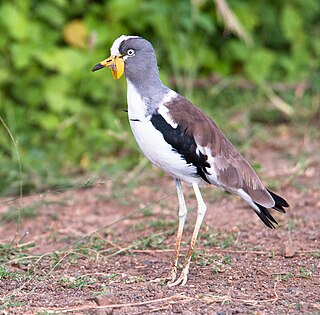
The white-crowned lapwing, white-headed lapwing, white-headed plover or white-crowned plover is a medium-sized wader. It is resident throughout tropical Africa, usually near large rivers.
Microcaecilia albiceps is a species of caecilian in the family Siphonopidae. It is found in the Amazonian lowlands and slopes of the eastern Andes in Colombia and Ecuador, possibly extending into Loreto in Amazonian Peru.

The light-crowned spinetail is a species of bird in the Furnariinae subfamily of the ovenbird family Furnariidae. It is found in Bolivia and Peru.

The white-crested elaenia is a species of bird in subfamily Elaeniinae of family Tyrannidae, the tyrant flycatchers. It is found in Bolivia, Chile, Colombia, Ecuador, and Peru.

The white-headed saw-wing, also known as the white-headed rough-winged swallow is a species of bird in the family Hirundinidae. It is found in Angola, Burundi, Democratic Republic of the Congo, Ethiopia, Kenya, Malawi, Rwanda, South Sudan, Tanzania, Uganda, and Zambia.
Ctenosia is a genus of moths in the subfamily Arctiinae. The genus was erected by George Hampson in 1900.

Chrysomya albiceps is a species belonging to the blow fly family, Calliphoridae.
Cangetta is a genus of moths of the family Crambidae.
The white-headed blind snake is a species of snake in the Typhlopidae family.

Brachypelma albiceps is a species of spider in the tarantula family, Theraphosidae. It is known as the Mexican golden red rump tarantula or the Amula red rump tarantula. The carapace is a light golden color and the abdomen dark, covered with long red hairs. Females typically live for about 15 years. Males usually live about 5 years or up to 12 months after the last molt.

Parachronistis albiceps, the wood groundling, is a moth of the family Gelechiidae. It is found in most of Europe, except the Iberian Peninsula and part of the Balkan Peninsula. Outside of Europe, it is found in southern Siberia, the Russian Far East and Korea.
Eupithecia albiceps is a moth in the family Geometridae. It is found in Peru.
Ctenosia infuscata is a moth of the subfamily Arctiinae. It was described by Oswald Bertram Lower in 1902. It is found in Australia.
Ctenosia inornata is a moth of the subfamily Arctiinae. It was described by Alfred Ernest Wileman. It is found on Luzon in the Philippines.
Ctenosia nephelistis is a moth of the subfamily Arctiinae. It was described by George Hampson in 1918. It is found in Kenya and Malawi.
Ctenosia psectriphora is a moth of the subfamily Arctiinae. It was described by William Lucas Distant in 1899. It is found in South Africa.
Garudinodes albiceps is a moth of the family Erebidae. It was described by Rothschild in 1912. It is found in New Guinea.
Ocinara albiceps is a moth in the family Bombycidae. It was described by Francis Walker in 1862. It is found in Sundaland. The habitat consists of lowland areas, especially alluvial forests, as well as the lower montane zone.

Philonicus albiceps is a species of 'robber fly' belonging to the family Asilidae. It is a Palearctic species with a limited distribution in Europe

The Chilean elaenia is a species of bird in subfamily Elaeniinae of family Tyrannidae, the tyrant flycatchers. It is found in Argentina, Bolivia, Brazil, Chile, Colombia, Paraguay, Peru, and Uruguay.








